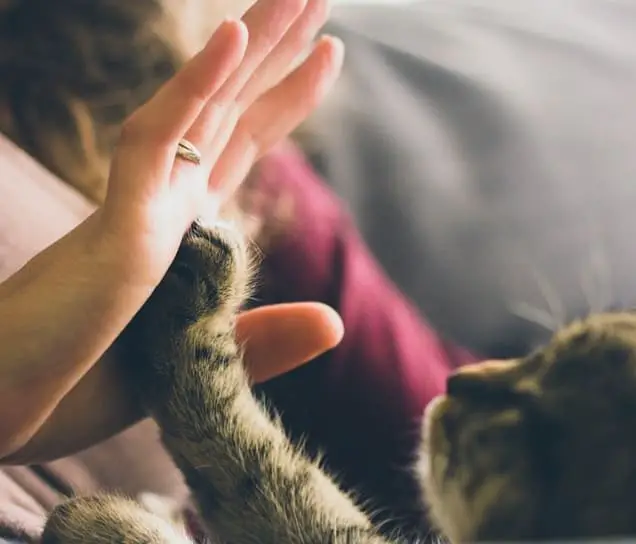
Cats are considered a “balm for the soul”.
Anyone lucky enough to live with an animal knows this perfectly well: pets have the extraordinary ability to improve our mood . And this is why for some time now dogs, horses and lately also cats have been used in the so-called pet therapy . But how can cats help in pet therapy , and what characteristics do they need to have in order to be educated to do it professionally?
Our feline friends can become little therapists thanks to their ability to feel empathy . For a cat it makes no difference whether his human is sick, elderly or disabled: the only aspect that matters is the quality of the relationship: “If you treat me well, I’ll be close to you and show you my affection”.
A cat has no ulterior motives: this unconditional acceptance, so rare and precious, is a real balm for the soul, especially for people who have suffered.
Benefits of cat Therapy:
For some time, several psychologists have pointed out that animals can have very positive effects on patients with psychological or mental problems . And in fact more and more often dogs, horses and even llamas are used in pet therapy. Cats are also becoming very popular as co-therapists. Thanks to their hypersensitive nature, in fact, they are able to “ touch the soul ” of those who suffer and can make a difference in the treatment process aimed at people in difficulty.
In fact, it was found that cats have a calming effect on many patients , even if only with their presence in a doctor’s office . A kitten that sleeps placidly, curled up on the sofa in a waiting room, or that approaches new patients in a friendly and curious way, helps to reduce the fears of the patient and is able to transmit confidence.
The cats in the waiting rooms of the doctors’ offices also serve to ” break the ice “: the conversation between the specialist and the patient becomes easier if you can entertain a little while talking about the animal, before starting the visit. The cat lightens the atmosphere and reduces the tension that can exist when dealing with serious or painful issues.
The hormones of happiness: the benefits of being close to a cat
The positive influence of cats on the human spirit is something scientifically proven. Researchers have found that when a cat is stroked , the human brain releases more happiness hormones . And at the same time, the production of those related to stress is reduced.
The cat’s purring is able to lower the blood pressure of the person next to him, limiting the risk of heart attack. The human brain reacts to the purr by releasing serotonin , also known as the “happiness hormone”.
Cats used in pet therapy have a calming effect and offer important support in treating sick children.
Cat therapy for children
It is especially the youngest who benefit most from a therapy that also involves animals. The children with autism , for example, have difficulty communicating with other people. In general, they struggle to grasp the nuances and emotions of others, tend to take what is said to them literally, and have difficulty interpreting feelings.
Cats, on the other hand, always relate directly and freely. Ambiguity, ulterior motives and irony are concepts completely foreign to them. They communicate their emotions in a unique way, a quality that makes them more understandable to children, helping them to open up .
Cat therapy is also often used with children who have so-called attention deficit disorder (ADHD) . Kittens have shown that they can help these young patients find their inner focus and focus.
Cats in nursing homes for the elderly
Contact with cats is a treasure not only for people with psychological discomfort but also for the elderly. In the past, the presence of pets in nursing homes was frowned upon. Pets were considered too demanding because they need someone to take care of them every day and because it is not easy to reconcile the needs of an animal with compliance with the hygiene rules that facilities for the elderly must respect.
Fortunately, the general attitude has changed: it has been recognized that animals have important beneficial effects on the elderly . Thus, for some years now, retirement homes have increasingly allowed new residents to take their pet with them. And there are structures that permanently house a cat, inside them, or that offer a cat therapy service conducted by a specialized operator, for the benefit of all guests.
Cats involved in cat therapy in nursing homes represent an important diversion for the elderly who spend often long and monotonous days, and are always a varied and pleasant topic of conversation . Animals provide physical closeness and warmth to nursing home residents, who often suffer from loneliness. A cat can lie on the lap of an elderly person and remain asleep for hours, for example: ideal, to keep company with a person in a wheelchair.
Cats help people with dementia and Alzheimer’s
In the case of guests with dementia, the presence of a cat in the facilities where they live has been shown to improve their attention, communication and empathy .
A few years ago the “Catalina Springs Memory Care” retirement home in the US state of Arizona started a very special project. It was decided to involve guests with Alzheimer’s by encouraging them to take care of some orphaned kittens, present in the local shelter. The cats needed to be bottle-fed several times a day.
Although at the beginning there was no lack of doubts regarding the ability of these elderly people to carry out such a task, there was a marked improvement in the conditions of these people , who seemed to “blossom” thanks to being able to take care of the kittens in difficulty.
Note: Often people with dementia and Alzheimer’s get better , if they can take care of a cat: in many cases the proximity to such a sensitive animal activates processes that slow the progression of the disease.
Which cats are suitable for pet therapy?

Regarding the requirements that a cat must have in order to be used in pet therapy, let’s immediately say that age, breed and sex play a relevant role .
Whether or not a cat is suitable to play the role of co-therapist is primarily a matter of character. The first requirement is that the animal is not afraid of people. He should therefore have been accustomed to contact with people immediately and feel comfortable in the company of human beings in general.
Very important: cats used in pet therapy must never represent a potential danger to “their” patients. For this reason, they should never bite or scratch, even if a person is particularly clumsy or nervous. Therefore, only extremely friendly and patient animals are fit for purpose .
Obviously, cats employed as co-therapists in different structures have to deal with frequent movements and consequently they should not be afraid of traveling in pet carrier .
To become a “therapist” a cat must be healthy
It goes without saying that a cat who is employed as a co-therapist within facilities, or in contact with patients, must first of all be a healthy animal . By regularly coming into contact with elderly or sick people, these animals must be regularly dewormed and receive all the appropriate vaccinations.
Also, they shouldn’t be fed following the BARF diet , that is to say with raw meat: the germs contained in it, in fact, could be dangerous for people with a particularly compromised immune system.






